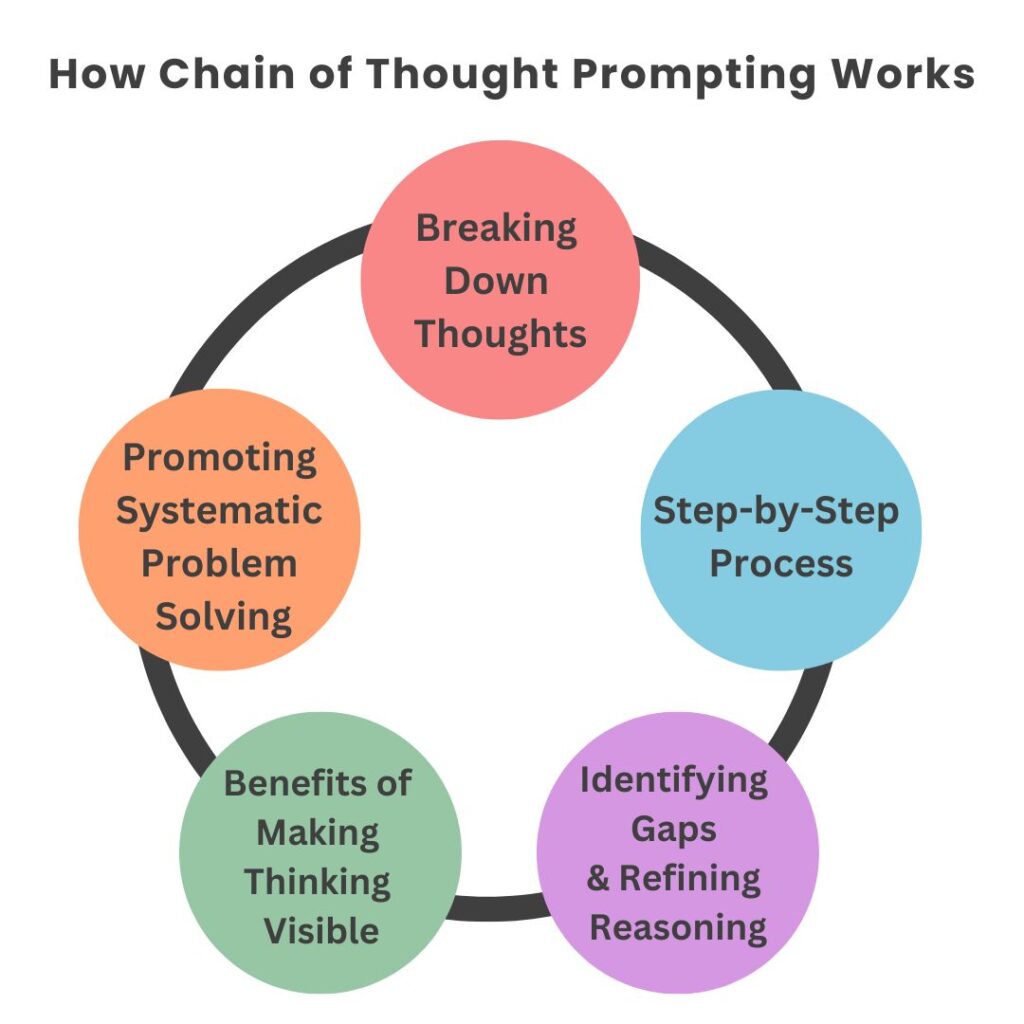Are you curious about the latest techniques in problem-solving and critical thinking? Look no further than Chain of Thought Prompting!
Chain of Thought (CoT) Prompting is a technique for guiding large language models through reasoning steps. It breaks down complex tasks into smaller parts, making the answer more accurate and easier to understand.
In this blog post, we will discuss what a chain of thought prompting is, how it works, and its benefits. Let’s get started!
Table of Contents
- What is Chain of Thought Prompting?
- Chain of Thought Prompting Benefits
- How Chain of Thought Prompting Works
- Tips for Effective Chain of Thought Prompting
- Examples of Chain of Thought Prompting
- Limitations and Considerations
- Future of Chain of Thought Prompting
- FAQ’s
- Conclusion
What is Chain of Thought Prompting?

Chain of Thought (CoT) Prompting is a method that helps people think through problems or questions step by step. It’s like having a conversation with yourself, where you break down a big idea into smaller, easier-to-understand parts.
When using CoT Prompting, you start with a question or problem and then slowly work through it, describing each step as you go. This helps you see the connections between different pieces of information and makes it easier to find solutions.
By taking the time to think through each part of the problem, you can better understand the whole situation and come up with more creative answers.
CoT Prompting is a powerful tool for learning, problem-solving, and making decisions. It’s simple to learn and can be used by people of all ages and backgrounds.
Chain of Thought Prompting Benefits

Chain of Thought Prompting offers several advantages that can help you improve your thinking skills and solve problems more effectively. Let’s explore some of the key benefits:
1. Enhances Problem-Solving Abilities
- Breaks down complex problems into manageable steps
- Encourages a systematic approach to finding solutions
- Helps identify gaps in understanding and reasoning
2. Promotes Clear Communication
- Improves the ability to explain thoughts and ideas
- Develops coherent and logical reasoning
- Enables better collaboration and teamwork
3. Boosts Creativity and Innovation
- Encourages thinking outside the box
- Facilitates the generation of new ideas and perspectives
- Helps identify unconventional solutions to challenges
4. Increases Self-Awareness
- Allows for reflection on one’s own thought processes
- Helps recognize biases and assumptions
- Promotes a deeper understanding of personal strengths and weaknesses
5. Supports Learning and Skill Development
- Reinforces new concepts and information
- Encourages active engagement with learning materials
- Helps transfer knowledge to real-world applications
6. Enhances Confidence and Decision-Making
- Provides a structured approach to decision-making
- Increases confidence in one’s ability to tackle challenges
- Helps justify and defend choices made
By incorporating CoT Prompting into your problem-solving toolkit, you can unlock these benefits and improve your overall thinking skills.
How Chain of Thought Prompting Works

Here is the breakdown of how chain of thought prompting works:
1. Breaking Down Thoughts
- CoT Prompting encourages individuals to break down their thinking process into smaller, interconnected steps.
- This helps to uncover the underlying logic and reasoning behind their ideas.
2. Step-by-Step Process
- The process starts with stating the initial question or problem.
- Individuals then break down their thinking into manageable chunks.
- Each step is clearly articulated using linking words like “because,” “therefore,” or “as a result.”
3. Identifying Gaps and Refining Reasoning
- As individuals work through the process, they may identify gaps in their reasoning.
- They can then gather more information to refine their thinking and strengthen their arguments.
- This leads to a more robust and well-supported conclusion.
4. Benefits of Making Thinking Visible
- CoT Prompting makes the thinking process visible and explicit.
- This helps individuals better understand their own reasoning.
- It also allows them to communicate their ideas more effectively to others.
5. Promoting Systematic Problem-Solving
- The technique promotes a systematic and thorough approach to problem-solving.
- It encourages individuals to consider multiple perspectives.
- It also helps them explore alternative solutions.
By breaking down the thinking process and making it more transparent, CoT Prompting enables individuals to develop stronger reasoning skills and approach problems in a more structured and effective manner.
Tips for Effective Chain of Thought Prompting
To make the most out of Chain of Thought Prompting, consider these tips:
- Tip 1: Start with a clear question or problem
- Tip 2: Break it down into smaller steps
- Tip 3: Use simple and concise language
- Tip 4: Be thorough and detailed
- Tip 5: Identify connections and patterns
- Tip 6: Ask questions and challenge assumptions
- Tip 7: Practice regularly
- Tip 8: Seek feedback and collaboration
By following these tips, you can enhance your CoT Prompting skills and unlock the full potential of this powerful problem-solving technique.
Examples of Chain of Thought Prompting
To better understand how Chain of Thought Prompting can be applied in real life, let’s explore a few examples:
Example 1: Solving a Math Problem
Imagine you’re trying to solve a complex math problem. Using Chain of Thought Prompting, you might approach it like this:
- First, I need to identify the key information given in the problem.
- Then, I should determine what the question is asking me to solve.
- Next, I can break the problem down into smaller, more manageable steps.
- I can start by solving the first step, showing my work, and explaining my reasoning.
- Once I’ve completed the first step, I can move on to the next one, building upon my previous work.
- If I get stuck, I can go back and review my steps to see if I’ve made any mistakes or missed any important information.
- After completing all the steps, I can double-check my answer to ensure it makes sense in the context of the original problem.
Example 2: Making a Decision
Chain of Thought Prompting can also be useful when making important decisions. Consider this example:
- I need to decide whether to accept a job offer in a new city.
- First, I should list the pros and cons of taking the job.
- Some pros might include a higher salary, better career opportunities, and the chance to live in a new place.
- Some cons could be leaving behind friends and family, the cost of relocating, and the uncertainty of adapting to a new environment.
- Next, I should consider how this decision aligns with my long-term goals and values.
- I can also think about the potential impact on my personal and professional life.
- After weighing the pros and cons and considering my goals and values, I can make an informed decision.
Example 3: Analyzing a Book or Movie
Chain of Thought Prompting can be applied to analyze a book, movie, or other work of art:
- I want to analyze the themes and symbols in a novel I just read.
- First, I can list the main characters and their roles in the story.
- Then, I can identify the key events and turning points in the plot.
- Next, I can look for recurring motifs, symbols, or patterns throughout the book.
- I can consider how these elements relate to the overall themes and messages of the story.
- I can also think about the historical, cultural, or personal context in which the book was written and how that might influence its meaning.
- By exploring these different aspects of the book and explaining my reasoning, I can develop a deeper understanding and appreciation of the work as a whole.
These examples demonstrate the versatility of Chain of Thought Prompting and how it can be applied to a wide range of situations, from solving problems to making decisions and analyzing information.
Limitations and Considerations
While Chain of Thought Prompting is a powerful tool, it’s important to recognize its limitations. It may not be suitable for all types of problems, especially those that require quick, intuitive decisions.
Additionally, the quality of the results depends on the individual’s ability to articulate their thoughts clearly and logically.
It’s crucial to be aware of potential biases and to consider alternative perspectives when using this technique.
Future of Chain of Thought Prompting
As more people discover the benefits of Chain of Thought Prompting, we can expect to see its use expand across various fields and industries.
Researchers may continue to refine and adapt the technique to suit different contexts and learning styles.
The integration of technology, such as AI-powered writing tools, could make Chain of Thought Prompting even more accessible and effective in the future.
FAQ’s
Prompt chaining involves a series of separate prompts, while the chain of thought prompting encourages a step-by-step explanation of the thinking process within a single prompt, linking ideas together to reach a conclusion.
Few-shot prompting provides examples for the model to learn from, whereas chain-of-thought prompting encourages the model to break down its reasoning process step-by-step, explaining the connections between ideas to arrive at a solution.
Conclusion
In conclusion, Chain of Thought Prompting is a valuable technique that can help individuals improve their problem-solving, decision-making, and critical thinking skills. By breaking down complex ideas into smaller, interconnected steps, it promotes clear reasoning and effective communication.
While it has its limitations, Chain of Thought Prompting offers a structured approach to tackling challenges and fostering deeper understanding. As we continue to explore its potential applications, this technique may become an increasingly important tool for personal and professional growth.


1 thought on “What is Chain Of Thought Prompting & How Does It Work?”